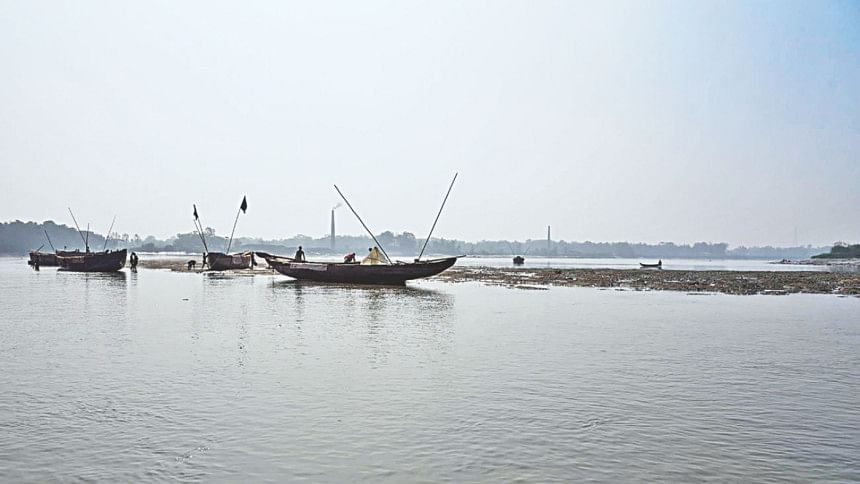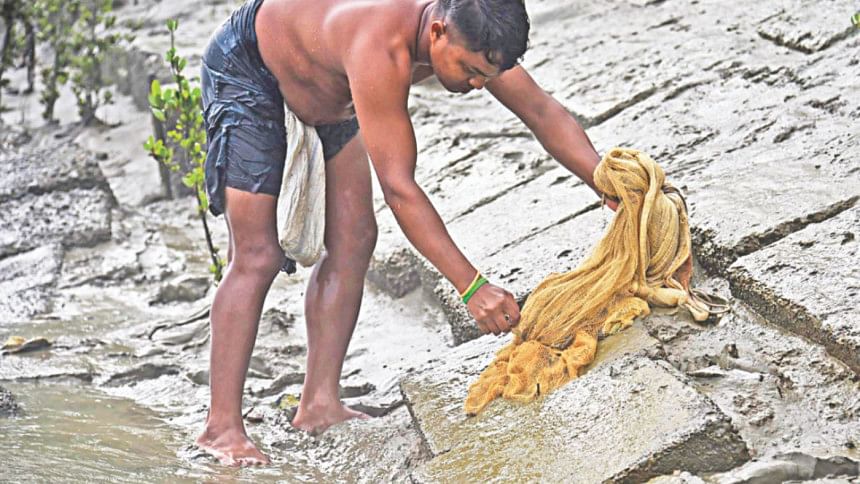Halda losing fish species

The Halda river, the lone source of natural carp breeding in South Asia, lost 26 of its fish species in the past seven years because of water pollution and an ailing biotic community due to the dams and dikes built on both side of the river.
The river in south-eastern Bangladesh originates at the Badnatali Hill Ranges in Ramgarh upazila in the Chittagong Hill Tracts, and flows through Fatikchhari upazila, Bhujpur Thana, Hathazari upazila, Raozan upazila and Chandgaon Thana of the Chittagong, and falls into the Karnaphuli River.
The 98-kilometre long river has a turbulent tributary, the Dhurung River, which joins Purba Dhalai about 48 kilometres downstream. The river is navigable by both big and small boats as it reaches up to 21 feet in depth, reaching even 30 feet at its deepest point.
A study completed last year -- Impact Assessment on Upstream Water Withdrawal to Conserve Natural Breeding Habitat of Major Carps in the River Halda -- looked at the various factors responsible for the loss in its fish species. It pointed at the residue released by factories, siltation, tobacco farming and sand extraction as primary reasons.

The research was financed by the fisheries and livestock ministry and jointly conducted by Bangladesh University of Engineering Technology, Bangladesh Agricultural University and Chittagong University.
The twelve-month study carried out between March 2015 and February 2016 found at least 26 fish species have disappeared from the Halda.
Some of the species that are no longer found are Goni Chapila, Iisha, Telipasha, Chital, Foli, Mrigal, Koksa, Ghor Poia, Guijja Ayre, Meni, Dhela, Chep Chela, Teri Punti, Baleetora, Pabda, Madhu Pabda, Tengra, Shilong.
Other lost species include Dhain, Batasi, Pangwash, Ghajal, Koitor Poa, Poa, Baila and Nuna Baila.
Dr Manjururl Kibria, a professor of Zoology at Chittagong University, who was on the research team, said there were 76 fish species in the river according to a similar study in 2009.
That figure has now come down to 50, he told The Daily Star.
The river stream has seen the construction of dams from 1976 to 2011 that has reduced the flow of water, causing ecological disturbance to the riverbank and food chain. This resulted in fewer plankton and benthos that are essential food sources for various species of fish.
The Water Development Board built dams at Dhurong Khal while the Local Government Engineering Department set up rubber dams at Bhujpur union and Harualchori.
Across the Halda and its tributaries, there are many agricultural fields that require water for irrigation. These dams have benefitted the farmers of these regions but were set up in an unplanned way.
Where the river originates, there is an expanse of tobacco farming on both sides of the shore. The pesticides and fertilisers that are sprayed on the tobacco plants all wash into the river stream and also affect the underwater ecosystem.
Factory waste released through the Khandokia canal and Katakhali canal into the river are also accountable for the presence of harmful chemicals in the water, he added.
The research team has seen the extensive impact of rubber dams on the plankton community, Kibria said.
Planktons have deteriorated drastically in the spawning period (April-June) downstream, while it was high at the same location during post spawning season (July-October).
“The team recorded the lowest amount of biotic community at the site of the rubber dam. It also harms the benthic community (aquatic animal population), which lies at the bottom of the river, at the points of Harualchori and Bhujpur where two rubber dams are in operation.”
The poor number of benthos is prevalent during November-March when the river becomes almost dry, as water extraction begins in full swing for crop cultivation.
Kibria added that the government prohibited fishing permanently from Madunghat to Nazirhat in a gazette issued in 2010.
“The decision let the kachkey (Corica Soborna) fish to breed in huge numbers. This specie eats up much of the plankton, harming other species in the river,” he added.
The research suggested that the authorities take steps to stop indiscriminate sand extraction from 13 legal and 20 illegal Balu Mohal (sand station) of Halda, tobacco farming at Manikchari, pollution from factories, save the oxbow and protect the brood fish.
Kamal Uddin, a resident of Gorduara union adjacent to Halda River, who once fished in the area, said they used to catch various species of fish in the past. But many species like Pabda, Modhu Pabda and Guijja Ayre have disappeared now.
District Fisheries Officer Mominul Haque said not only in Halda, but various fish species are going extinct from the swamps as well.
He blamed indiscriminate fishing and pollution for this and underscored the need for creating sanctuaries to save the fish species.

 For all latest news, follow The Daily Star's Google News channel.
For all latest news, follow The Daily Star's Google News channel. 







Comments